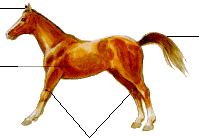

Cause
Signs
Epidemiology
Immunity
Treatment
Control
Why vaccinate?
What about the use of Tetanus Antitoxin?
Does the vaccine cause a reaction?
How is the vaccine administered?
What is the vaccination schedule?
What do we give to an unvaccinated horse with a wound?
Need to know more?
Tetanus occurs when a wound becomes infected with bacterial spores of Clostridium tetani. These spores germinate, multiply and produce a very powerful poison which affects the muscles. Some cases of tetanus occur from wounds that are so small they are not noticed.
An affected horse moves with a stiff-legged gait, often with the tail held out stiffly and the ears pricked. As the disease progresses the muscles become so rigid and stiff that the horse may fall and not be able to get up again. Convulsions may occur and death is caused by paralysis of the breathing muscles.
| Ears held pricked up |
 |
Tail held out and stiff |
| Paralysis of breathing muscles |
||
| Stiff legged gait |
Persistent spores can be found in the soil (it is more prevalent in cultivated than uncultivated soils) and organisms are routinely isolated from the faeces of many domestic animals, including the dog and cat, and also from humans.
Animals that have recovered from natural infection are not immune and still require vaccination for protection.
Treatment is difficult, time consuming, very expensive and often unsuccessful. It involves the use of tetanus antitoxin (Equivac TAT) to neutralise unbound circulating toxin, penicillin to prevent further growth of C/. tetani, muscle relaxants to relax the rigid muscles, and supportive therapy until the toxin is eliminated or destroyed.
Vaccination is the only way to provide safe, effective long-term protection against tetanus. If an unvaccinated horse is injured, tetanus antitoxin should be administered to provide immediate but short-term (3 weeks) protection. At the same time a vaccination program should be commenced to develop long-lasting immunity. The tetanus vaccine (Equivac-T) may be administered intramuscularly on one side of the neck, while the tetanus antitoxin is injected subcutaneously on the other side of the neck. A separate syringe and needle should be used for each product. This will result in both immediate and long lasting protection.
Tetanus vaccine alone provides long-lasting protection but immunity takes 7-10 days to develop, and an injured horse may develop tetanus before protection is achieved. Tetanus antitoxin alone provides protection in 2-3 hours but it only lasts for 3 weeks and tetanus may develop after this protection has waned. Therefore, simultaneous injection of 1500 units of Equivac TAT and 1mL of Equivac-T provides optimal immediate and long-term protection. These injections should be given on different sides of the neck. Another dose of Equivac-T four weeks later is required for long-lasting protection.
Vaccination is the only way to provide long term protection against tetanus. It should be remembered that the horse is the most susceptible animal to tetanus.
Tetanus antitoxin provides immediate protection but this protection only lasts for 3 weeks. Horses given tetanus antitoxin can develop tetanus once the levels of antitoxin have dropped below the protective level. It is extremely risky if owners are relying on the use of tetanus antitoxin given to horses, after a wound, to protect them against tetanus, as some cases of tetanus occur from wounds which are so small they are not noticed.
Like a number of other vaccines, Equivac-T or Equivac 2 in 1 can cause a local swelling at the site of the injection. Provided the injection has been carried out aseptically, any swelling should resolve spontaneously.
The vaccine is injected intramuscularly. The most convenient site for injection is the centre of the side of the neck.
For all horses and foals, three months of age and above, the primary vaccination course consists of two injections of Equivac-T or Equivac 2 in 1, four weeks apart, followed up by a booster dose one year later. Boosters after this are recommended every five years.
In these cases administer 1500 units ( 1 syringe) of Equivac-TAT on one side of the neck and 1 mL (1 syringe) of Equivac-T on the other side of the neck. This regime provides immediate and lasting protection. The dose of Equivac-T should be repeated four weeks later.
(Antitoxin alone has limited usefulness owing to the shortness of its protective action and a single dose of Tetanus Vaccine given to an unimmunised horse at the time of wounding or surgery may not prevent tetanus. This is why the simultaneous injection of Equivac-TAT and Equivac-T is recommended. Provided that only 1500 units of Equivac-TAT is given, there will be no interference with the development of active immunity.)
Pfizer Veterinary Services
Toll Free Phone: 1 800 814 883
Fax: 02 9850 3399
Website:
www.pfizeranimalhealth.com.au
E-mail: animal.health@pfizer.com
Pfizer Australia Pty Ltd. 38-42 Wharf Rd,
West Ryde, NSW 2114.
™ Trademark of Pfizer Animal Health.